
Adonis is a genus of about 20–30 species of flowering plants of the crowfoot family, Ranunculaceae, native to Europe and Asia.
Plants belonging to the genus Pachypodium vary widely from each other in some aspects, but also share a number of basic common traits. Each species is adapted to the specific environment which it inhabits, but all species of the genus share certain anatomical and metabolic traits, reflecting their common evolutionary ancestry.

Pachypodium ambongense is a species of plant in the family Apocynaceae. It was first published as a species of the genus Pachypodium in 1924 by the botanist Henri Louis Poisson.
Pachypodium bicolor is a species of plant in the family Apocynaceae.

Pachypodium brevicaule is a species of plant that belongs to the family Apocynaceae.
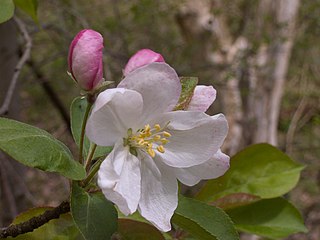
Malus coronaria, also known by the names sweet crabapple or garland crab, is a North American species of Malus (crabapple).
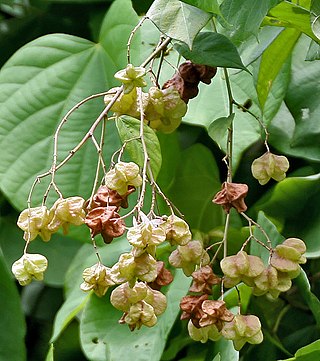
Kleinhovia is a monotypic genus of plants in the cotton, hibiscus and cacao family Malvaceae. The sole species in the genus is Kleinhovia hospita, commonly known as guest tree, an evergreen tree native to Indonesia, Malaysia and other parts of tropical Asia and the Pacific.
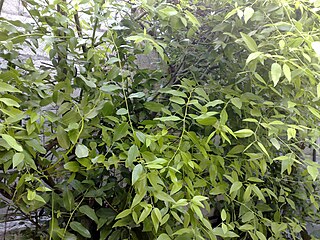
Litsea glaucescens, also called Mexican bay leaf, is an evergreen tree or shrub 3–6 metres (9.8–19.7 ft) high in the genus Litsea belonging to family Lauraceae. It is native from southern North America, mostly in Mexico. Distributed by Mexico and Central America.

Coccinia intermedia is a species of Coccinia which was first described in 2011 by Norbert Holstein.
Adenorandia is a monotypic genus of flowering plants in the family Rubiaceae. It was described by Vermoesen in 1922. The genus contains only one species, viz. Adenorandia kalbreyeri, which is found from west-central tropical Africa.
Trompettia cardenasiana is a species of nightshade that is a spiny shrub bearing very small leaves, 0.35–0.5 cm (0.1–0.2 in) by 0.1–0.12 cm (0.04–0.05 in), a yellow trumpet-shaped campanulate flower, measuring about 3 cm (1.2 in) long and globose fruit. The growth habit is somewhat reminiscent of certain Lycium species. It is endemic to Bolivia, growing in dry, Andean valleys at elevations of 2,000–2,500 m (6,600–8,200 ft) and 3,000–3,500 m (9,800–11,500 ft) and has been collected near the town of Cotagaita in Potosí Department.

Psychotria capensis, the bird-berry, is a southern African evergreen shrub or small tree. It belongs to a genus which is used medicinally in many regions, 'Psychotria' being from the Greek for 'rejuvenating', in reference to the healing properties of certain species. Kew lists some 2,000 species of Psychotria growing throughout the warmer regions of both hemispheres, but only two of them occur in southern Africa, namely P. capensis and P. zombamontana.

Karomia speciosa is an African deciduous large shrub or bushy tree up to 7 m, and relocated to the family Lamiaceae from Verbenaceae. It is one of 9 species in the genus Karomia, a genus containing species previously classified in Holmskioldia, and is closely related to Clerodendrum. The only remaining species in the genus is Holmskioldia sanguinea, occurring in the foothills of the Himalayas.
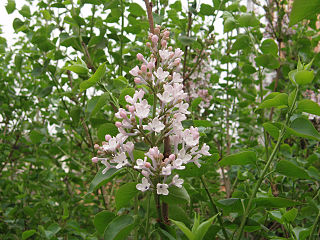
Syringa oblata is a species in the genus Syringa, in the family Oleaceae. It is also known as early blooming lilac or broadleaf lilac.
Syringa pinetorum is a species in the genus Syringa, in the family Oleaceae.
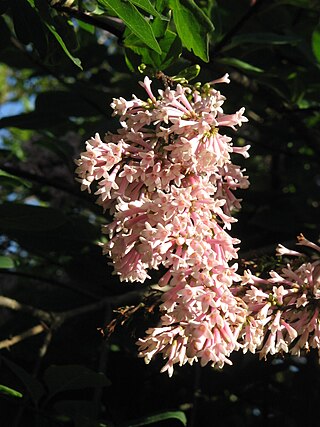
Syringa tomentella is a species in the genus Syringa, in the family Oleaceae.

Cinnamomum kanehirae, also known as small-flowered camphor tree, or stout camphor tree, is a tree within the genus Cinnamomum of the family Lauraceae endemic to Taiwan.
Hypericum cuisinii is a perennial herb in the genus Hypericum, in the section Adenosepalum. The herb has pale yellow flowers and occurs in Greece and Turkey.
Stenostephanus brevistamineus is a species of flowering plant first collected 11 July 2013 in Junín, Peru. Stenostephanus is a genus in the plant family of Acanthaceae. The species holotype is housed at HOXA, with isotypes at MO and USM.
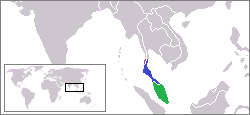
Barclaya panchorensis is a species of perennial aquatic plant endemic to Peninsular Malaysia.














